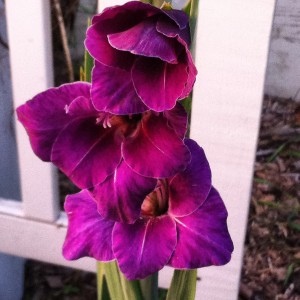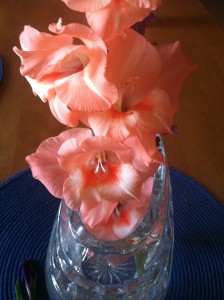Plant Profile: Gladiolus
 Gladiolus is one of those old-fashioned flowers that is enjoying a renaissance. Maybe it’s because florists love them for bouquets, or because more gardeners are growing cutting gardens, but gladioli are not just for grannies anymore.
Gladiolus is one of those old-fashioned flowers that is enjoying a renaissance. Maybe it’s because florists love them for bouquets, or because more gardeners are growing cutting gardens, but gladioli are not just for grannies anymore.
It’s easy to see why: They are easy to grow, produce striking blooms, can be grown in containers, in a bed with perennials or annuals or in rows for cut-flower bouquets. We Minnesota gardeners should be especially proud to plant glads because they have a connection to our northern state. St. Charles, MN, was home to Carl Fischer, one of the world’s leading gladiolus hybridizers. (His Friendship gladiolus was introduced in 1949, but is still considered an excellent variety.) In his 98 years (more than 70 of them raising glads), Fischer created dozens of hybrids on his 10-acre spread in St. Charles. Every August, the city celebrates Gladiolus Days to honor Fischer, who died in 2005, and treat visitors to the sight of rows and rows of gladiolus. To see this man amid his life’s work, check out this video made when he was 87.
Growing Gladiolus in Minnesota
 Gladioli are summer-blooming annual bulbs in Minnesota. Technically, the plants are corms. These root structures must be pulled every fall and replanted each spring. You can treat glads as annuals or dry and store the corms over the winter.
Gladioli are summer-blooming annual bulbs in Minnesota. Technically, the plants are corms. These root structures must be pulled every fall and replanted each spring. You can treat glads as annuals or dry and store the corms over the winter.
Choose corms that are large for their weight. Anything less than an inch across is unlikely to flower. Don’t rush to put these in the ground either. Wait until mid-May, when all danger of frost is past and the soil has had a chance to warm up. For a sequence of blooms, consider planting every two weeks from mid-May to mid-June.
Gladioli like a well-drained site in full sun. If your soil is clayish, consider raised beds or even containers for growing your gladiolas. Plant them six inches apart and at a depth that is twice the bulb’s width. Some sources recommend a light fertilizer with extra phosphorous for blooms, such as a 5-10-5. Glads need about an inch of water a week once they start growing from rain or the hose. Blooms should begin to appear about 10 weeks after planting. Because they can get tall, some glads need staking.
When the blooms begin to open, you can cut the flower spikes with a sharp knife at an angle. Put the spikes immediately into a bucket of water and allow them to “harden off” in a cool spot before using them in bouquets. The University of Minnesota has an excellent page on gladiolas for detailed information.
What’s your favorite flower for indoor arrangements?

2 Comments
-
Pingback: Summer Bulbs: Planting and Care Tips - Minnesota State Horticultural Society
-
Pingback: Plant Profile: Begonias - Minnesota State Horticultural Society
Back to Blog